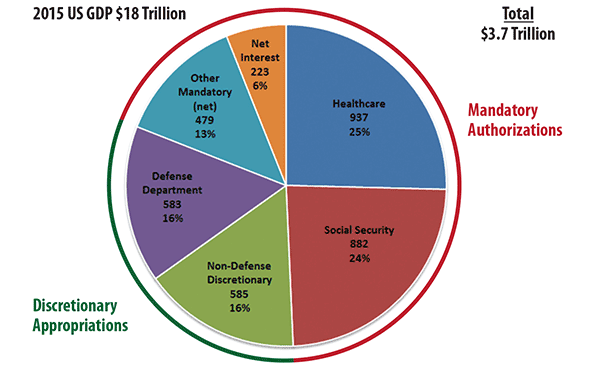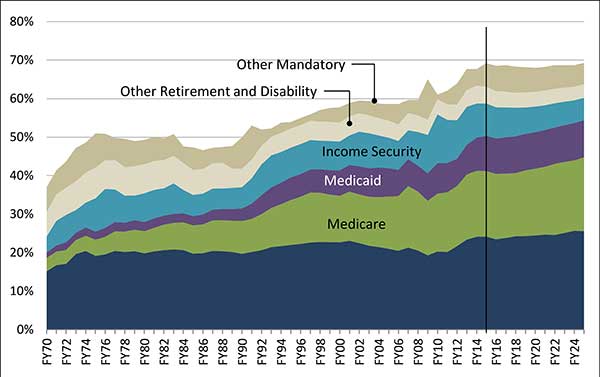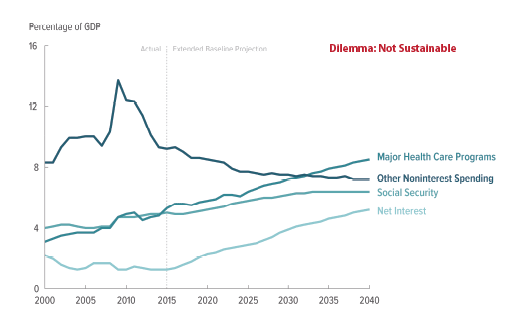5173 Lesson Federal Spending and Entitlement Programs Review
When I gave a presentation at the APS "Apr" Meeting final January I had just completed my appointment as the Director of Science at the U.Due south. Section of Energy (DOE), which as the APS News readership knows is the largest funder of physical science research in the federal government.
I hadn't actually paid a lot of attending to the entire federal upkeep until I became a federal employee, then I plant it to exist quite sobering.
This Back Page commodity is spread in 2 parts across two issues of APS News. Kickoff, in Part One in the September issue, I covered some historical trends in U.S. enquiry and evolution (R&D) funding, contrasted with that of another nations, then provided an early June update on the assistants's proposed budget for next fiscal yr (FY18) and a call to the physics customs to answer.
In this Part Two, I will give a brusque tutorial on the federal budget as a whole and where R&D fits into it, and a mid-September update on the congressional budget marks for FY18.
The Federal Budget — a Tutorial
As a reminder from Function One, the U.S. federal government is normally working on three almanac budgets simultaneously. The budget for fiscal yr (FY) 2017, from Oct ane, 2016 to September thirty, 2017, is beingness executed past agencies now. Allow's call that budget the FY budget.
At the same time, the FY+1 upkeep is under consideration past Congress; that budget is (normally) submitted to Congress by the president during the first week in February of FY, i.due east., 4 months after the beginning of FY and eight months prior to the start of FY+ane. Congress must assess this budget, normally through hearings and testimony, and enact 12 split up appropriations for the FY+ane budget.
Considering of the turnover in the presidential assistants terminal Jan, submission to Congress of the president's FY18 proposed budget was delayed until late May, and congressional upkeep hearings were held for FY18 in June and July. The House has just, in mid-September, passed a package of twelve appropriations bills, and the Senate Appropriations Committee is in the procedure of passing appropriations bills out of its various subcommittees.
Concurrent with congressional consideration of the FY+1 budget, the administration is formulating the FY+2 budget, a process led by the Office of Direction and Budget (OMB) and negotiated separately with each bureau; the conception process can accept as long as ane year prior to the submission to Congress.
Effigy i shows a pie chart of the U.South. federal budget enacted in 2015 (FY15)

Fig. 1: Pie chart of the U.S. 2015 financial year enacted budget showing mandatory and discretionary parts

Fig. 2: Historical Growth and Projections of the Mandatory Programs

Fig. iii: Congressional Budget Office Projections for Spending in a Business organization-as-Usual Scenario. The meridian in 2009-2010 is the stimulus spending of the 2009 American Recovery and Reinvestment Act. Other noninterest includes all discretionary spending.
The FY15 enacted federal budget was $3.7 trillion. 2 thirds of it was "mandatory." This includes what are called entitlement programs: Social Security, and the major healthcare programs for retirees and low-income earners, Medicare and Medicaid, forth with other programs similar unemployment, food stamps, federal housing loan programs, veterans' retirement, and the net interest on the U.S. national debt.
The mandatory parts of the budget are mostly not appropriated (Social Security is appropriated, but it's nevertheless considered a mandatory entitlement programme) and they are authorized by bills in Congress through various authorizing committees. Some are authorized for many years, but many are authorized for just a unmarried year.
Relevant to physical science research is the "discretionary" spending, a yearly budget process through the appropriations committees of Congress. This comprises about one-half defence force and half nondefense spending. And the inquiry and development (R&D) function of each of those is nigh 10%; together a very small slice of the total federal budget — roughly 3%.
Here is an issue: For the past 50 years, the U.S. has been running an annual budget deficit, and information technology'southward getting worse. The differences betwixt federal outlays and revenues have averaged well-nigh three% of the U.S. gross domestic product (GDP), currently around $18 trillion. Nosotros must borrow money to pay for these ~3% per twelvemonth deficits, with the net involvement on the federal debt role of the mandatory part of the upkeep.
In its proportion of the federal budget and in existent dollars, mandatory spending has been climbing dramatically, and discretionary spending, which includes R&D budgets, has been going downwardly. The federal budget is now two-thirds mandatory versus one-third discretionary, rather than the other style effectually every bit in the 1970's.
Within mandatory spending Medicare and Medicaid are growing the well-nigh rapidly. Social Security is growing also but not as rapidly. The Congressional Budget Office (CBO) projections for the mandatory programs are shown in Figure 2.
In fiscal year 1970, about 16 people were paying into the system for each worker getting Social Security and Medicare entitlement program retirement and inability benefits. Today, there are nigh 3 people paying into the system for every i recipient. The baby boomers are at present get-go to retire. In 2024 there will be 2 people paying in for each recipient.
If we proceed with our current policies then our deficit is but going to get worse, with a ballooning cyberspace interest payment. In Figure 3 y'all can come across this in the CBO projections assuming business organisation as usual out to 2040.
Our national debt is now larger than GDP and comparable in current dollars to what it was in Globe War II — and if y'all simply extend what we're doing today, then our interest payments get three times larger by 2040. This is not sustainable.
About 20% of the about $20 trillion current national debt is held past foreign countries, the largest holders being China and Japan. This is a strategic take chances and not internationally sustainable.
What this means is that in the next few years spending caps such as the 2011 "sequester" on the discretionary spending levels tin can go only so far: nosotros will need to begin to address the biggest cause of the problem: net hereafter spending on the major entitlement programs Medicare, Medicaid and Social Security.
If we cannot contain the spending on the major entitlement programs, federal spending on the discretionary part of the budget, including R&D — our investment in the future — will continue to decrease.
As of mid-September, there has been no understanding on healthcare spending reform, the assistants, the House and the Senate are all in negotiations about raising the debt ceiling for temporary hurricane relief, a short continuing resolution keeps the authorities operating until early Dec, and Congress is working hard on passing all of the appropriations bills. The Senate subcommittee marks and the House marks for the appropriations restore much of the president's proposed drastic cuts to research spending for FY18 to close to FY17 levels, with some stiff differences between the House and Senate marks in some of the applied research programs such every bit energy, space, and manufacturing. Both major funders of basic physics research, National Science Foundation and the DOE Part of Science, can wait that "level is the new up." It behooves you to keep to tell stories of the impact that your research has had, and make the argument that although federal R&D funding in a broad mix of fields is just 3% of the almanac budget, information technology is a critically of import investment in the future of our nation.
The author is Benjamin Peirce Professor of Technology and Public Policy in the John A. Paulson School of Engineering and Practical Sciences and Professor of Physics, Harvard University. She served as the Director of the Department of Energy's Office of Scientific discipline from 2015 until 2017, overseeing $5.5 billion in research funding too as the direction of 10 national laboratories. She was dean of the School of Engineering science and Applied Sciences at Harvard from 2009 until 2014, and master acquaintance director for science and technology from 2007 to 2009 and deputy director for science and technology from 2004 to 2007 at Lawrence Livermore National Laboratory. From 1978 to 2004, Murray held a number of positions at Bell Laboratories (Lucent Technologies). She served equally APS president in 2009, and is a member of the National Academy of Sciences and National Academy of Engineering as well every bit a Swain of the American Academy of Arts and Sciences.
Source: https://www.aps.org/publications/apsnews/201710/backpage.cfm